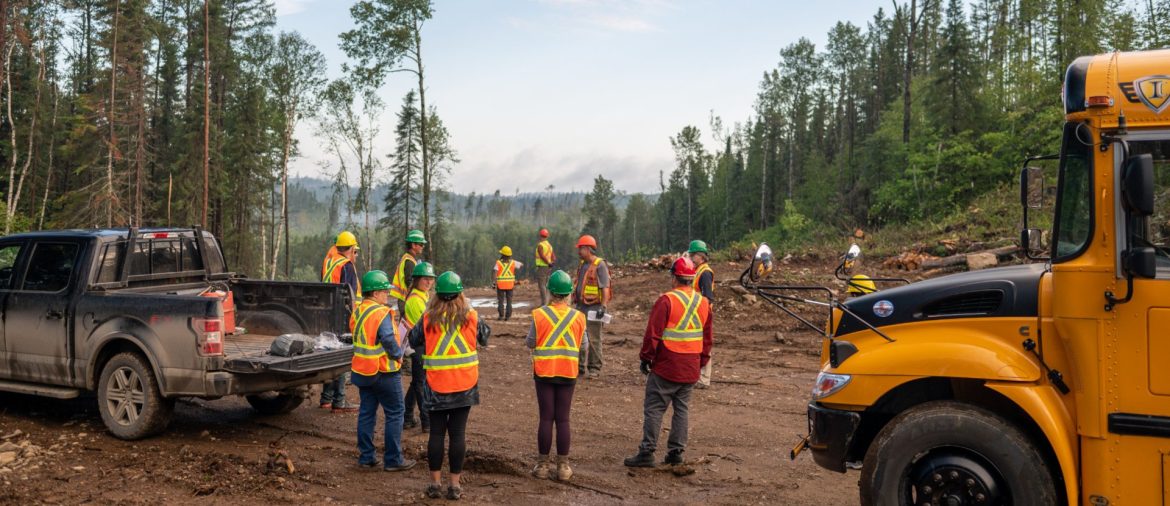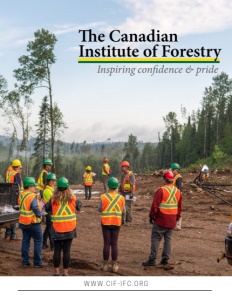The Canadian Institute of Forestry
Inspiring confidence & pride
Business View Magazine interviews Mark Pearson, Executive Director of the Canadian Institute of Forestry, for our focus on Sustainable Forest Management
The Canadian Institute of Forestry (CIF-IFC) has served as the national voice of forest practitioners in Canada since 1908, making it the oldest not-for-profit forest organization in the country. The CIF-IFC represents a diverse group of people with interest in forests and forestry including (but not limited to) foresters, forest technologists and technicians, ecologists, biologists, and educators.

Mark Pearson, CIF-IFC Executive Director
The CIF-IFC is proud to be an interdisciplinary and inclusive organization, with 1,300 members from 18 regional Sections across Canada and one International Section. Executive Director Mark Pearson, explains, “Our Sections are the backbone of the CIF-IFC. They give us a strong local and regional network and presence. Our National Office, comprised of 12 team members and headquartered in Mattawa, Ontario works closely with our Sections to support their local initiatives and to provide national leadership in forestry and forest stewardship, promote competency among forest practitioners, and foster public awareness and education of forest and forestry issues.”
The Institute offers three individual memberships: active, student and retired. They also have a Sustaining Corporate Membership Program, where organizations can join the CIF-IFC network, receive valued benefits and recognition as a financial supporter of CIF-IFC programs and initiatives. Members offer dedicated expertise to ensure Canada’s forests are vibrant, healthy and sustainable. Communication with members is done through a quarterly membership e-newsletter, bi-annual membership magazine The Leader, e-notices, website posts, social media, and The Forestry Chronicle – the Institute’s scientific and professional journal since 1925.
Each year, they also host a National Conference and Annual General Meeting, bringing together forest practitioners and alike, and providing opportunities for networking and engagement. “Our 2022 Conference that was hosted this September in Sault Ste. Marie, Ontario was our first in-person Conference since 2019, with over 200 delegates in attendance,” says Pearson. “Our next Conference will be held in Nanaimo in 2023, and in St. John’s in 2024. Additionally, we are working with the Society of American Foresters towards hosting a joint Conference in 2026.”
Historically, forests were viewed as boundless sources of resources. By the 1970s an awakening of other forest values led to environmental regulations being implemented. Additionally, there has been an increasing recognition of the unique rights and relationships Indigenous peoples have related to forests. According to Natural Resources Canada’s 2021 State of Canada’s Forests Report, 184,510 people are directly employed by Canada’s forest sector. This includes approximately 12,000 Indigenous Peoples.
Pearson emphasizes, “Given the immense benefits of our forests, it is critical that they are sustainably managed, and Canada remains a global leader in sustainable forest management. Since 1990, less than half of 1% of the forest lands in Canada have been changed to a non-forest land use. Canada’s already low deforestation rate is expected to not only to remain low, but to decrease. Currently, there is a lot of misinformation about forestry that exists in the public sphere. As those involved in the sector it is important that we dispel these myths and inform the general population that Canadian forests are sustainable, productive, and prosperous.”
One of the core mandates of the CIF-IFC is to provide national leadership in forestry, including advocacy and outreach. As the voice of forest practitioners, the CIF-IFC speaks up for the world-class sustainable forest management practices found in Canada and educates the value of forests as a renewable resource. Pearson notes, “Trees not only sequester carbon; they help clean water and reduce erosion to prevent floods. Planting the right tree, in the right location, and for the right reasons will help mitigate and adapt to climate change.”
“Newly added to our suite of advocacy products are information bulletins, where readers can get a quick snapshot on ‘hot topics’ in the forest sector such as wildfire smoke, watersheds, clearcutting, old growth, caribou, as well as pieces clarifying misconceptions about deforestation and forest carbon quantification and accounting,” Pearson says.
Innovation thrives as the forest sector continues to rise to the challenge brought on by climate change. The sector is at the forefront of making buildings more sustainable, energy efficient, and resilient. Building with wood has a lower carbon footprint and captures carbon during construction. Additionally, wood is highly versatile and reusable which helps limit waste. Since wood is a natural insulator, wood buildings are able to use less energy for heating and cooling.
Bioproducts are another example of how forestry is at the leading edge of innovation and environmental solutions. Wood-fibre residues and by-products from manufacturing are being utilized to make biochemicals, biomaterials, and bioenergy. From biofuels being used to provide energy in remote communities to wood fibre-based bioplastics replacing single-use plastic bags, advances in forestry are creating a more sustainable world.

The 2022 CIF-IFC National Conference & 114th AGM brought together over 200 delegates from across the Canada and abroad to network and learn about the latest in forestry – their first in-person Conference since 2019. Hosted from September 11-14, 2022 in Sault Ste. Marie, ON.
According to Pearson, “The innovation we are seeing in forestry is creating economic opportunities and supporting communities across Canada, while also providing sound solutions in the fight against climate change.”
In collaboration with stakeholders, the CIF-IFC has demonstrated a successful Open Urban Forests pilot project proposal intended to establish the first national view of urban forestry geospatial data in Canada. This project is ground-breaking not only for its scope, but for ensuring this data is easily findable, discoverable, and interoperable. Furthermore, the project would enable access to urban forestry geospatial data across Canada, regardless of where data is stored and the formats in which it is stored, through the creation of a learning hub for students, academics, and other groups with an interest in urban forestry.
The outcomes of the project would have a number of benefits. It would support measuring the continuous effects of climate change and other trends on urban forests across Canada and would better inform policy/decision makers of the impacts of climate change mitigation measures.
The CIF-IFC also welcomes new graduates to the field of forestry through the Silver Ring Program. Graduates from a CIF-IFC recognized forestry program have been receiving silver rings from the Institute since 1967. The silver ring is a symbol of achievement and provides visible evidence of a national bond uniting Canadian forest practitioners and professionals.
Another key initiative in the forest sector is Free to Grow in Forestry. Led by the CIF-IFC in partnership with the Centre for Social Intelligence, this initiative aims to create a diverse and inclusive workforce that provides the foundation for a thriving forest sector and healthy communities.
The CIF-IFC is dedicated to inspiring confidence and pride in Canadian forestry both across Canada and internationally. Pearson adds, “We are committed to ensuring that the Canadian forest sector is welcoming and inclusive to all individuals, and that members from underrepresented groups know they are welcome and aware of the many career opportunities available to help meet Canada’s labour demands. Additionally, we want to educate the value of forests and their importance as a renewable resource to audiences beyond the forest sector. This is especially important as the sector and forests are connected to our daily lives in so many ways.”
Among the strategic objectives of the Institute is to increase the scope of educational efforts to reach the next generation of forest stewards and audiences beyond the forest sector. One way they do this is by hosting Teachers’ Forestry Tours for educators, teachers, and teaching candidates to meet forest practitioners. The tours offer a very well-rounded and great introduction to forests and the forest sector, while also providing participants with resources and tools to bring back to the classroom. Pearson reports, “This past year we’ve hosted tours across Canada in collaboration with our Sections and local organizations. The feedback has been very positive, with teachers finding the presentations, hands-on-learning, and opportunities to visit forests, harvesting sites, and product mills highly beneficial.”
Each year, the CIF-IFC leads National Forest Week (NFW), which encourages individuals to learn more about forests as a valuable and renewable resource. NFW 2022 took place from September 18-24th with the theme “Canada’s Forests: Solutions for a Changing Climate”. Pearson notes, “As part of this program, we lead the distribution of promotional materials including posters and postcards featuring the annual NFW theme. This year, with support from partners and sponsors, over 25,600 printed materials were distributed across Canada – an all-time record. We coordinated a social media campaign and hosted a number of NFW-themed activities and contests.” In addition, the CIF-IFC collaborated with Resources Works to engage with communities across Canada and bring awareness to NFW. “In 2022, approximately 57 towns, cities, municipalities, regions, provinces and territories declared National Forest Week through a proclamation, lighting of a local building, or both,” states Pearson.
Another strategic objective of the CIF-IFC is to provide competency to forest practitioners (knowledge exchange, professional development and continuing education), through workshops, field tours and webinars. Pearson says, “It’s an exciting time to be a CIF-IFC member!”
AT A GLANCE
Canadian Institute of Forestry (CIF-IFC)
What: A not-for-profit, member-based organization serving as the voice of forestry practitioners
Where: Mattawa, Ontario
Website: www.cif-ifc.org


